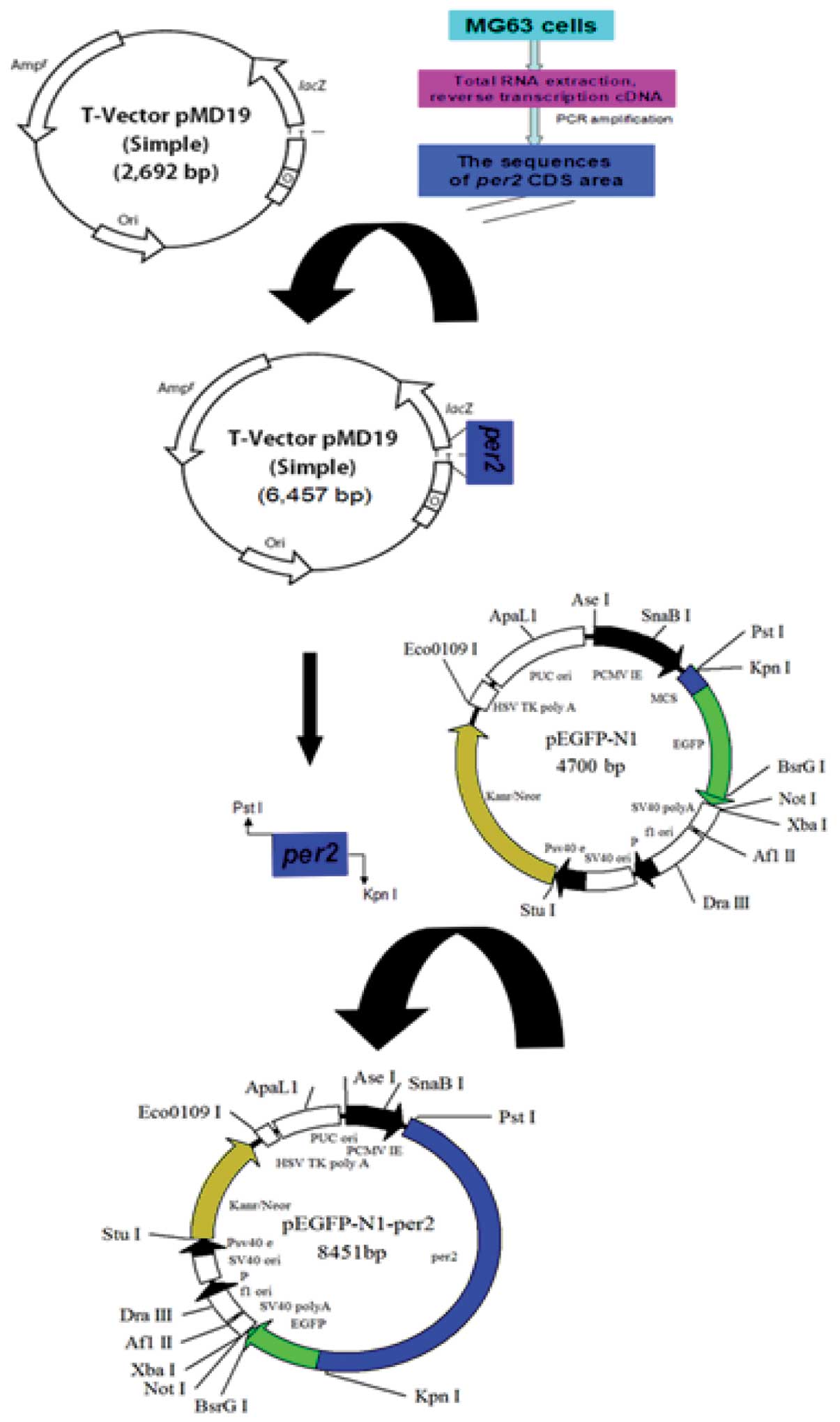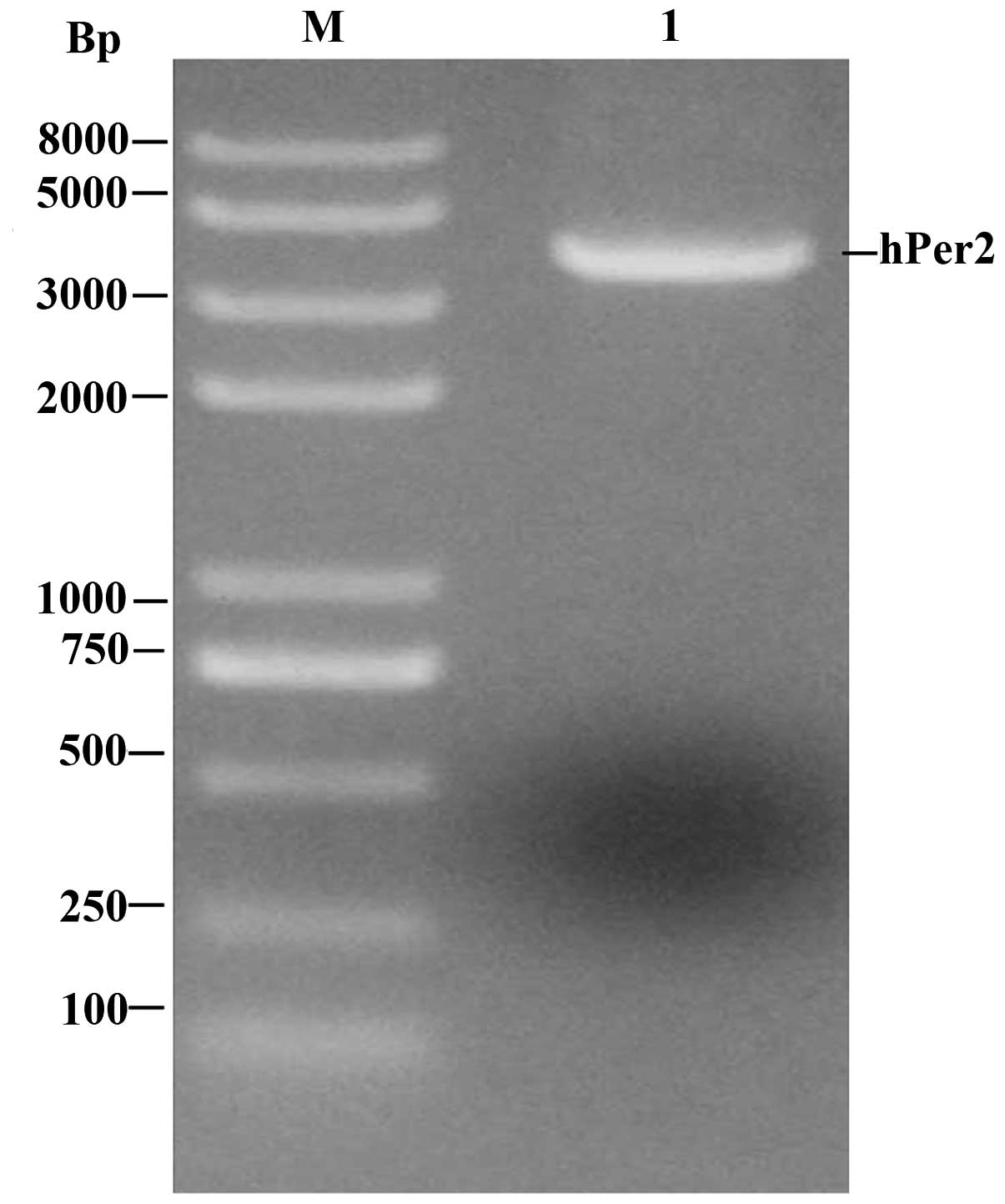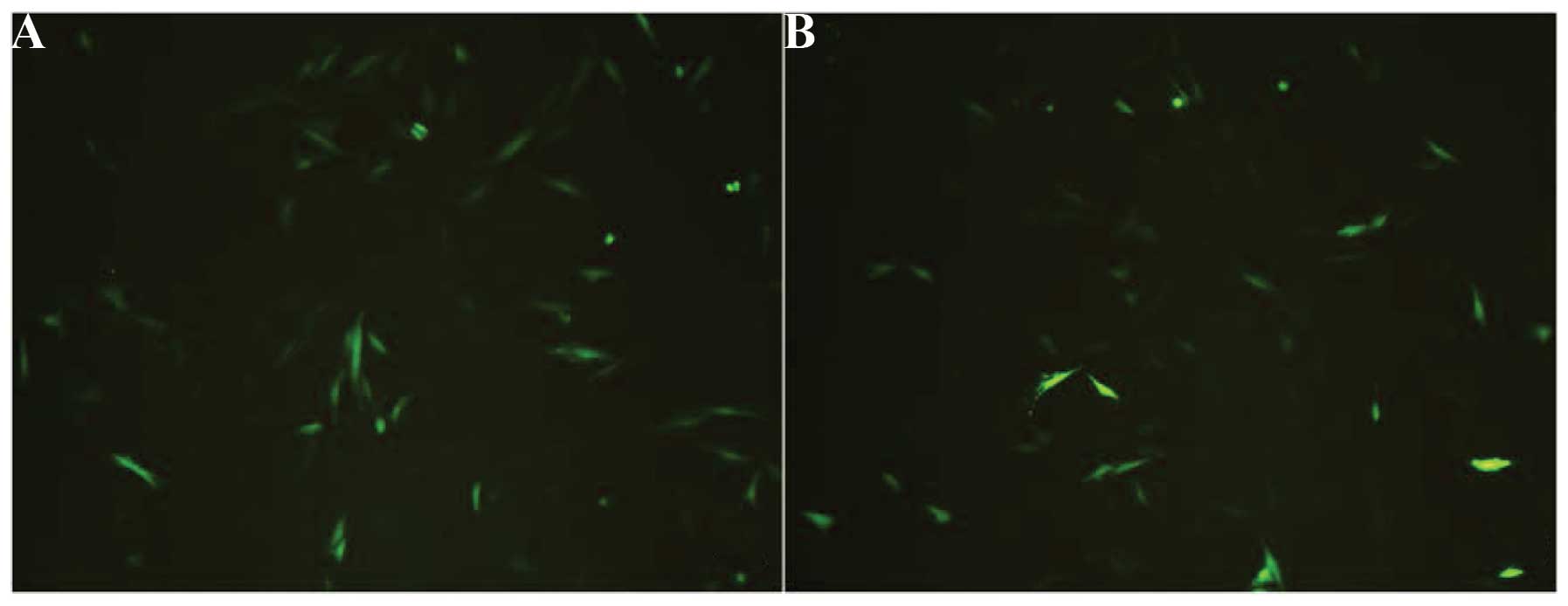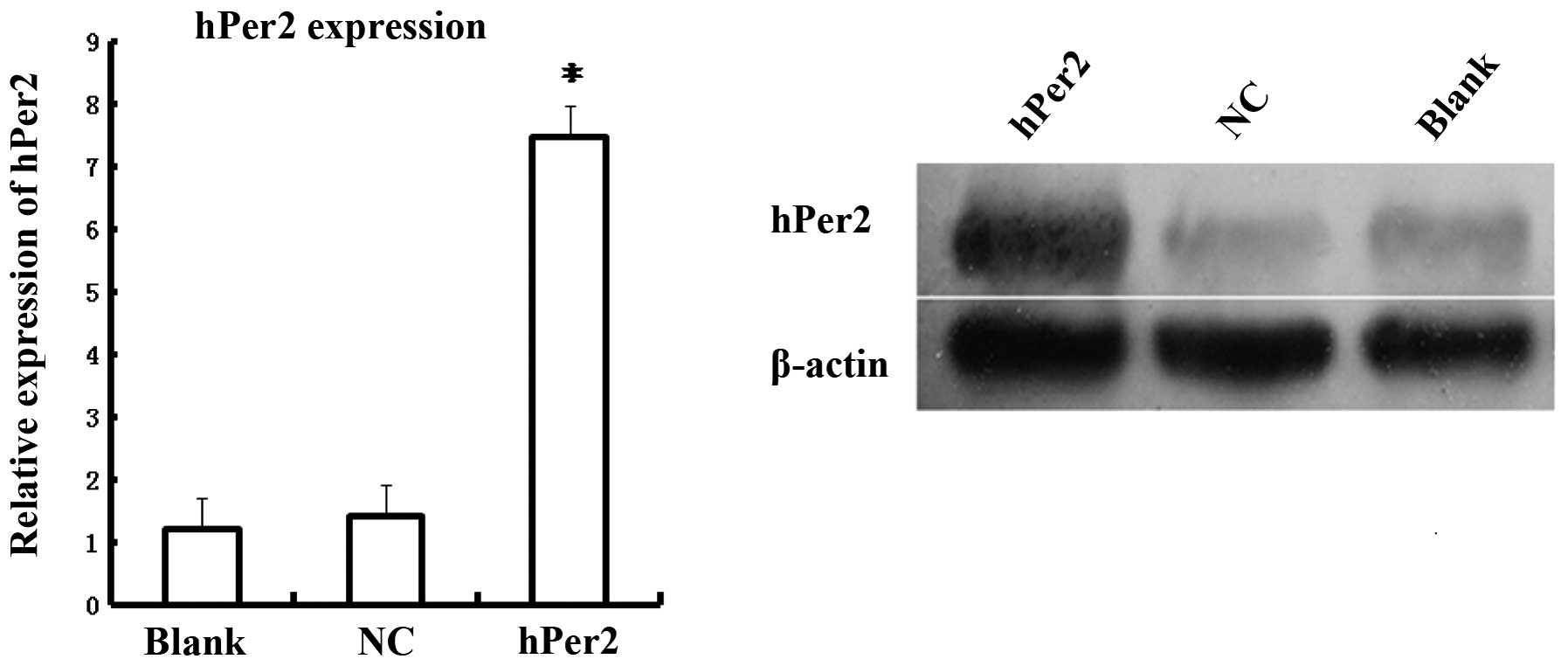Construction of recombinant pEGFP‑N1‑hPer2 plasmid and its expression in osteosarcoma cells
- Authors:
- Published online on: March 1, 2016 https://doi.org/10.3892/ol.2016.4291
- Pages: 2768-2772
-
Copyright: © Cheng et al. This is an open access article distributed under the terms of Creative Commons Attribution License.
Abstract
Introduction
The daily light/dark cycles of the Earth are responsible for the physiological and behavioral activity of a number of organisms. This temporal activity is known as circadian rhythm, and has a biological molecular basis, namely the circadian gene (1,2). Previous studies have demonstrated that the circadian genes regulate several molecular and biochemical processes as well as having an established role in the mammalian circadian clock. Research suggests that the role of the circadian clock may be a fundamental regulator for tumor suppression in humans (3,4). Several cancer studies indicate that period 2 (Per2), one of the key circadian genes, plays a significant role in growth control and tumor development (5). To understand the effects of Per2 on osteosarcoma cell growth in vitro, the recombinant pEGFP-N1-hPer2 plasmid was constructed using the vector pEGFP-N1 carrying the fluorescent protein gene and transfected into MG63 cells using Lipofectamine 2000, then the expression of hPer2 in MG63 cells was assessed by reverse transcription-polymerase chain reaction and western blot analysis. This research is expected to lay the foundations for research into the circadian gene in osteosarcoma.
Materials and methods
Materials
The MG63 osteosarcoma cell line was purchased from the Cell Bank of Wuhan University (Wuhan, China); the pMD19-T vector, Escherichia coli DH5a and DNA marker were purchased from Transgen Biotechnology (Beijing, China); PstI and KpnI restriction enzymes were purchased from NEB (Ipswich, MA, USA); the plasmid pEGFP-N1 was purchased from Clonetech Biotechnology (Mountain View, CA, USA); the DNA ligation kit, RevertAid™ First Strand cDNA synthesis kit, dNTPs, RevertAid reverse transcriptase and HiFi DNA polymerase were purchased from Fermentas (Beijing, China); TRIzol™ reagent, Lipofectamine 2000 and radioimmunoprecipitation assay (RIPA) lysis buffer were purchased from Beyotime Institute of Biotechnology (Shanghai, China); AxyPrep DNA gel extraction kit was purchased from Takara Biotechnology, Inc. (Dalian, China); rabbit anti-hPer2 polyclonal antibody was purchased from ProteinTech Group, Inc. (Chicago, IL, USA; catalog no., 20359–1-AP); and Western Lighting Plus Chemiluminescence was purchased from PerkinElmer, Inc. (Waltham, MA, USA).
Methods
Gene amplification, cloning and sequencingTotal RNA was extracted from the osteosarcoma cell line MG63 using TRIzol reagent according to the procedure supplied by the manufacturer. Extracted RNA (1 µg) was used for cDNA synthesis with the RevertAid First Strand cDNA synthesis kit according to the manufacturer's instructions. The reaction system was prepared in a total volume of 20 µl containing 12.5 µl RNA primer mix, 4 µl 5X RT reaction buffer, 2 µl dNTPs, 1 µl RevertAid reverse transcriptase, 0.5 µl RiboLock RNase inhibitor and dH2O up to 20 µl. A pair of primers was designed based on the hPer2 mRNA sequence (Genbank no. NM_022817.2): PstI tailed forward (5′-AACTGCAGATGAATGGATACGCGGAATTTCC-3′) and KpnI tailed reverse (5′-CGGCTGCAGCGTCTGCTCTTCGATCCTGT-3′) primers (restriction sites are underlined) and named as hPer2-F and hPer2-R, respectively. The length of the amplification segment was 3765 bp. The PCR mixture was blended in a total volume of 20 ml containing 2 µl cDNA template, 1 µl each primer (10 µmol/l), 10 µl PCR mix and dH2O up to 20 µl. The PCR program was started at 94°C for 5 min, followed by 40 cycles at 94°C for 30 sec, 58°C for 30 sec, 72°C for 5 min and completed with a final extension at 72°C for 5 min. The final PCR products were separated by electrophoresis using 1% polyacrylamide gels, and the target fragment was purified and recovered using an agarose gel extraction kit (Watson Biomedical, Inc., Shanghai, China).
The purified target fragments were ligated into the plasmid pMD19-T and then transformed into competent E.coli DH5a cells. Recombinant plasmid was extracted from bacterial colonies and 1.0 µl plasmid solution was subjected to agarose gel electrophoresis to confirm the presence of the correct sequence of hPer2.
Construction of pEGFP-N1-hPer2 expression plasmidDouble restriction enzyme digestion was applied to the recovered target gene fragment and eukaryotic expression vector pEGFP-N1, respectively. The enzyme reaction contained 2 µl target gene fragment (or vector pEGFP-N1), 2 µl 10X Fast Digest buffer, 1 µl PstI, 1 µl KpnI and dH2O up to 20 µl. Under the guidance of the T4 DNA ligase system instructions, the purified target fragment of the hPer2 gene was directionally ligated into pEGFP-N1 vector in a 10-µl reaction system containing 3 µl target fragment, 1 µl pEGFP-N1, 1 µl T4 DNA ligase, 1 µl 2X Quick Ligation buffer and dH2O up to 10 µl. The reactants were well mixed at 16°C for 2 h, then the ligation was transformed into competent E.coli DH5a cells and inoculated into Luria-Bertani culture media containing 100 µg/ml ampicillin at a volume ratio of 1:100. After amplification by shaking the culture overnight at 37°C, the target plasmids were extracted from the bacterial liquid according to the instructions for the EndoFree Maxi Plasmid kit (Tiangen Biotech Co., Ltd., Beijing, China). The resulting recombinant eukaryotic expression vector was named pEGFP-N1-hPer2, and the construction procedure is shown in Fig. 1.
The pEGFP-N1-hPer2 was digested using PstI and KpnI, and then evaluated by agarose gel electrophoresis. The recombinant plasmid was further sequenced to confirm its sequence by the Beijing Genomics Institute (BGI; Beijing, China).
Transfection of pEGFP-N1-hPer2 into MG63 cellsMG63 cell lines originated from human osteosarcoma were used in this study. The cells were maintained and cultured in RPMI-1640 media supplemented with 10% fetal bovine serum, 100 U/ml penicillin and 100 µg/ml streptomycin (Biochrom KG, Berlin, Germany) at 37°C in a humidified 5% CO2 incubator. The cells were divided into three groups: pEGFP-hPer2, pEGFP-N1 and control. Cells were transiently transfected with the DNA construct using Lipofectamine 2000 reagent. In brief, following the manufacturer's instructions the transfection complex was prepared based on the optimized amounts of plasmid and Lipofectamine reagent and transferred to the 70–80% confluent MG63 cells, then cells were washed with phosphate-buffered saline (PBS) and collected to conduct subsequent assays.
Analysis of transfection efficiencyThe expression of enhanced green fluorescence protein (EGFP) was already visualized by fluorescence microscopy (Olympus IX51; Olympus Corporation, Seoul, South Korea) at 24 h post-transfection, and the percentage of fluorescence-emitting cells was determined by flow cytometry (FACSort; BD Biosciences, Franklin Lakes, NJ, USA).
Quantitative RT-PCR (RT-qPCR) analysisTotal RNA was isolated from MG63 cells using TRIzol reagent, and the concentration of each RNA sample was determined using a NanoVue Plus spectrophotometer (GE Healthcare Bio-Sciences AB, Uppsala, Sweden). All RNA samples were subsequently adjusted to the same concentration. An SYBR PrimeScript RT-PCR kit (Takara Biotechnology, Inc.) was then used for RT-PCR according to the manufacturer's instructions. The relative mRNA expression of hPer2 was analyzed by qPCR using the IQ™5 System (Bio-Rad Laboratories, Inc., Hercules, CA, USA) with β-actin (Genbank no. NM_001101) serving as the reference gene. The primer information is as follows: hPER2-F, TACACCGTGGAGGAGATGGAGA; hPER2-R, ATATGGATGCAACCTGGTCAGA; β-actin-F, GTCCACCGCAAATGCTTCTA; β-actin-R, TGCTGTCACCTTCACCGTTC. The PCR reactions were carried out in a 96-well plate in a 25 µl reaction volume. Each reaction mixture contained 12.5 µl SYBR-Green I PCR Master mix (Takara Biotechnology, Inc.), 2.5 µl normalized template DNA, 0.5 µl each primer and 9.5 µl sterile ultrapure water. The relative expression of hPer2 was calculated using the ‘normalized relative quantification’ method followed by the 2−∆∆Ct cycle threshold method (6). PCR reactions were performed in triplicate for each sample.
Western blot analysisFor western blot analysis, cells at 90% confluency were washed in PBS before incubation with RIPA lysis buffer consisting of 50 mM Tris, pH 7.4, 150 mM NaCl, 1% Triton X-100, 1% sodium deoxycholate, 0.1% sodium dodecyl sulphate (SDS) on ice for 10 min. The cell lysates were clarified by centrifugation at 9000 × g for 10 min, and the supernatants were collected. Protein concentration was measured by bicinchoninic assay (Aidlab, Beijing, China). Equal amounts of total protein were separated on 10% SDS-polyacrylamide gel, and then transferred electrophoretically to nitrocellulose membranes blocked with TBST buffer (50 mM Tris-HCl, pH 7.5, 0.15 M NaCl, 0.1% Tween-20) containing 5% fat-free dry milk for 2 h and incubated for 3 h with rabbit polyclonal anti-human hPer2 antibody (dilution, 1:500) in TBST. Following incubation with a horseradish peroxidase-conjugated goat anti-rabbit secondary antibody (dilution, 1:2000; catalog no., SA00001-2; ProteinTech Group, Inc.), immunoreactive proteins were visualized with an enhanced chemiluminescence detection system. The western blot experiments were repeated three times. The relative expression of the target protein was calculated as the gray value ratio of target protein content to β-actin content (target protein/β-actin) using Quantity One version 4.62 image analysis software (Bio-Rad Laboratories, Inc.).
Statistical analysisStatistical analyses were carried out with the SPSS version 17.0 (SPSS, Inc., Chicago, IL, USA) statistical software package for Windows. All analyses in this study were performed using analysis of variance. All P-values were based on two-tailed tests and P<0.05 was considered to indicate a statistically significant difference.
Results
Agarose gel electrophoresis of RT-PCR product
The results of RT-PCR demonstrated that there was a visible DNA band just below 4 kb which had the same size as the expectant target gene (the length of hPer2 was 3765 bp; Fig. 2).
Identification of recombinant expression vector
The DNA sequencing results revealed that the sequence of the 3765 bp inserted segment was identical to the cDNA sequence of the hPer2 gene. The results of nucleotide-nucleotide BLAST in NCBI also demonstrated that the sequence alignment was completely correct (Fig. 3). Following double enzyme digestion, a 3765-bp insertion segment and a 4.7-kb vector fragment were observed in the pEGFP-N1-hPer2 group following electrophoresis, while only a 4.7-kb vector fragment was observed in the pEGFP-N1 group. The results confirmed that the construction of the pEGFP-N1-hPer2 eukaryotic expression plasmid was successful (Fig. 4).
Transfection efficiency analysis of hPer2 gene in MG63 cells in vitro
The expression of the EGFP reporter gene was clearly observed using fluorescence microscopy (Olympus IX51) 48 h after transfection (Fig. 5) in the pEGFP-N1-hPer2 and the pEGFP-N1 group but not in the control group. The results revealed that in the pEGFP-N1-hPer2 and the pEGFP-N1 group, large numbers of MG63 expressed GFP. EGFP was expressed in 70% of cells in the pEGFP-N1-hPer2 group and 75% of cells in the pEGFP-N1 group, suggesting that pEGFP-N1-hPer2 and pEGFP-N1 may be effectively transfected into MG63 cells, resulting in a high level of EGFP expression. It was expected that the pEGFP-N1 group would express a more intense fluorescence signal than the pEGFP-N1-hPer2 group, since the empty pEGFP-N1 vector was smaller and had a higher transfection efficiency. In addition, as shown in Fig. 6, hPer2 mRNA expression was significantly higher in the pEGFP-N1-hPer2 group compared with the pEGFP-N1 or control groups (P<0.05), and no statistical difference existed between pEGFP-N1 and the control group (P>0.05), suggesting that hPer2 was successfully transfected into MG63 cells and efficiently expressed. Western blot analysis revealed that hPer2 protein exhibited a significant upregulation in the pEGFP-N1-hPer2 group compared with the pEGFP-N1 and control group (P<0.05), and no statistical difference existed between pEGFP-N1 and the control group (P>0.05). These data also demonstrated that human osteosarcoma MG63 cell lines were successfully generated, in which hPer2 was overexpressed.
Discussion
Osteosarcoma is the most common primary bone tumor and mainly affects children and adolescents (7,8). The etiology of osteosarcoma is largely unknown due to the difficulties in understanding the molecular mechanism of tumor development in the complex structure and numerous genomic rearrangements of bone cancer cells (9). Complete radical surgery remains a preferable choice in osteosarcoma treatment, with adjuvant chemotherapy administered prior to surgery (10). If surgical excision is not possible, the addition of radiation therapy may be beneficial to control the local tumor. Still, a number of patients with osteosarcoma risk having local relapse following chemotherapy (11). For this reason, it is crucial to explore novel and alternative strategies for osteosarcoma treatment. Understanding the fundamental molecular mechanisms in the pathogenesis of osteosarcoma may help to develop novel strategies that have a specific molecular target for the treatment of patients with osteosarcoma (12).
Life on earth has evolved in the presence of a rhythmically changing environment. Most eukaryotes, and certain prokaryotes, have developed a molecular time-keeping mechanism that synchronizes itself with the external environment to ensure optimal timing of cellular functions, metabolism and physiology (13–15). This mechanism is known as the circadian oscillator or clock. Circadian clocks have been identified in the majority of tissues and cells of mammals (16,17). The molecular basis of the circadian clock is the oscillatory transcription and translation of ‘clock genes’. Studies suggest that tumorigenesis is associated with altered circadian function, whether causal or symptomatic, and that a dysfunctional circadian clock promotes carcinogenesis (18). However, the effects of clock genes on the biological behavior of osteosarcoma cells are rarely reported. In the current study, we selected hPer2, one of the key circadian genes, and successfully constructed the recombinant pEGFP-N1-hPer2 plasmid, which was transfected into the MG63 osteosarcoma cell line. This study is expected to lay the foundation for research into the circadian gene in osteosarcoma. A gene transformation technique is applied to modify tumor cells with certain functional genes to increase inhibition effects on the growth of tumors. The development of this technique has been extremely rapid in recent years and has become a new method in the precaution and treatment of tumors (19).
GFP easily forms a fusion protein with other target genes and has no influence on the space conformation and function of the target gene product. It has become the optimal reporter gene for the detection of the target gene transfection efficiency and expression modality (20). EGFP is optimized mutant GFP possessing a much higher sensitivity and 35 times stronger fluorescence than the wild type, having no species specificity and a notable influence on the growth and function of cells (21).
Taken together, in this study, in order to detect the transfection efficiency of the hPer2 gene, we constructed a recombinant plasmid using EGFP which exhibits the changes of its expression position and quantity within MG63 cells. We investigated the function of the target gene in the occurrence and development of tumors, as well as the molecular mechanisms involved. Our preliminary studies provide the ground work for further research on the roles of the circadian gene hPer2 in MG63 osteosarcoma cells, and pave the way for future studies of the intracellular downstream signaling mechanisms responsible for hPer2′s ability to affect osteosarcoma cells.
Acknowledgements
The authors thank the Central Laboratory of the First Affiliated Hospital of Wuhan University, as well as Jishuang Zhu for his assistance in primer design and Dr Ling Yu for his careful review of the manuscript.
References
|
Partch CL, Green CB and Takahashi JS: Molecular architecture of the mammalian circadian clock. Trends Cell Biol. 24:90–99. 2014. View Article : Google Scholar : PubMed/NCBI | |
|
Kelleher FC, Rao A and Maguire A: Circadian molecular clocks and cancer. Cancer Lett. 342:9–18. 2014. View Article : Google Scholar : PubMed/NCBI | |
|
Greene MW: Circadian rhythms and tumor growth. Cancer Lett. 318:115–123. 2012. View Article : Google Scholar : PubMed/NCBI | |
|
Beckett M and Roden LC: Mechanisms by which circadian rhythm disruption may lead to cancer. S Afr J Sci. 105:415–420. 2009. | |
|
Ishida N: Circadian clock, cancer and lipid metabolism. Neurosci Res. 57:483–490. 2007. View Article : Google Scholar : PubMed/NCBI | |
|
Schmittgen TD and Livak KJ: Analyzing real-time PCR data by the comparative C(T) method. Nat Protoc. 3:1101–1108. 2008. View Article : Google Scholar : PubMed/NCBI | |
|
Ottaviani G and Jaffe N: The epidemiology of osteosarcoma. Cancer Treat Res. 152:3–13. 2009. View Article : Google Scholar : PubMed/NCBI | |
|
Admassi D: Osteosarcoma of medial cuniform bone. Ethiop Med J. 47:305–308. 2009.PubMed/NCBI | |
|
Martin JW, Squire JA and Zielenska M: The genetics of osteosarcoma. Sarcoma. 13:6272542012. | |
|
Yamamoto N and Tsuchiya H: Chemotherapy for osteosarcoma - where does it come from? What is it? Where is it going? Expert Opin Pharmacother. 14:2183–2193. 2013. View Article : Google Scholar : PubMed/NCBI | |
|
Luetke A, Meyers PA, Lewis I and Juergens H: Osteosarcoma treatment - where do we stand? A state of the art review. Cancer Treat Rev. 40:523–532. 2014. View Article : Google Scholar : PubMed/NCBI | |
|
Yang J and Zhang W: New molecular insights into osteosarcoma targeted therapy. Curr Opin Oncol. 25:398–406. 2013. View Article : Google Scholar : PubMed/NCBI | |
|
McWatters HG, Roden LC and Staiger D: Picking out parallels: Plant circadian clocks in context. Philos Trans R Soc Lond B Biol Sci. 356:1735–1743. 2001. View Article : Google Scholar : PubMed/NCBI | |
|
Levine JD: Sharing time on the fly. Curr Opin Cell Biol. 16:210–216. 2006. View Article : Google Scholar | |
|
Dong G and Golden SS: How a cyanobacterium tells time. Curr Opin Microbiol. 11:541–546. 2008. View Article : Google Scholar : PubMed/NCBI | |
|
Yoo SH, Yamazaki S, Lowrey PL, Shimomura K, Ko CH, Buhr ED, Siepka SM, Hong HK, Oh WJ, Yoo OJ, et al: PERIOD 2: LUCIFERASE real-time reporting of circadian dynamics reveals persistent circadian oscillations in mouse peripheral tissues. Proc Natl Acad Sci USA. 101:5339–5346. 2004. View Article : Google Scholar : PubMed/NCBI | |
|
Peirson SN, Butler JN, Duffield GE, Takher S, Sharma P and Foster RG: Comparison of clock gene expression in SCN, retina, heart and liver of mice. Biochem Biophys Res Comm. 351:800–807. 2006. View Article : Google Scholar : PubMed/NCBI | |
|
Hanahan D and Weinberg RA: Hallmarks of cancer: the next generation. Cell. 144:646–674. 2011. View Article : Google Scholar : PubMed/NCBI | |
|
Noda M, Takahashi C, Matsuzaki T and Kitayama H: What we learn from transformation suppressor genes: lessons from RECK. Future Oncol. 6:1105–1116. 2010. View Article : Google Scholar : PubMed/NCBI | |
|
Hoffman RM: Imaging metastatic cell trafficking at the cellular level in vivo with fluorescent proteins. Methods Mol Biol. 1070:171–179. 2014. View Article : Google Scholar : PubMed/NCBI | |
|
Sakharova NY, Mezhevikina LM, Smirnov AA and Vikhlyantseva EF: Analysis of the effects of blue light on morphofunctional status of in vitro cultured blastocysts from mice carrying gene of enhanced green fluorescent protein (EGFP). Bull Exp Biol Med. 157:162–166. 2014. View Article : Google Scholar : PubMed/NCBI |















